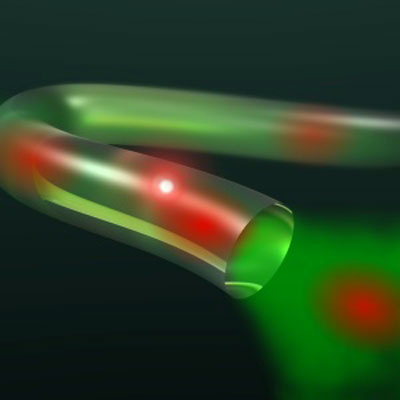|
from NatureAsia Website
A conception diagram of a tellurite glass optical fiber
with
embedded diamond nanoparticles as a source of single photons for
quantum computing Quantum computers promise a whole new level of processing power, solving problems of greater complexity in a shorter timeframe than is possible with conventional machines. A crucial requirement of quantum computing, however, is a material that can combine the quantum systems at the heart of quantum information up to the scale of a workable device.
Matthew Henderson and colleagues
from the University of Adelaide and University of Melbourne in
Australia have now produced just such a material by embedding
nanoparticles of diamond in tellurite glass.1
Quantum computers, on the other hand, use physical systems that are governed by the laws of quantum mechanics, dealing instead with quantum bits, or qubits.
Atomic-level defects in diamond are one such quantum system.
While diamond is fast developing as a useful material for quantum computing, significant challenges remain before it can be scaled up for practical applications.
Henderson and his colleagues examined an
alternative route to scaling up these qubits by embedding optically
active diamond nanocrystals in a conventional optical medium -
tellurite glass, which absorbs little light at the wavelengths
generated by the diamond defects.
The drawn fibers, however, have exciting potential for integration into micro-structured optical fiber systems and optical cavities.
Embedding the light source also leads to stronger coupling between qubits and the optical field.
Reference
Author affiliation
|

